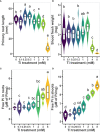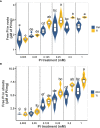Titanium nanoparticles activate a transcriptional response in Arabidopsis that enhances tolerance to low phosphate, osmotic stress and pathogen infection
- PMID: 36388557
- PMCID: PMC9664069
- DOI: 10.3389/fpls.2022.994523
Titanium nanoparticles activate a transcriptional response in Arabidopsis that enhances tolerance to low phosphate, osmotic stress and pathogen infection
Abstract
Titanium is a ubiquitous element with a wide variety of beneficial effects in plants, including enhanced nutrient uptake and resistance to pathogens and abiotic stresses. While there is numerous evidence supporting the beneficial effects that Ti fertilization give to plants, there is little information on which genetic signaling pathways the Ti application activate in plant tissues. In this study, we utilize RNA-seq and ionomics technologies to unravel the molecular signals that Arabidopsis plants unleash when treated with Ti. RNA-seq analysis showed that Ti activates abscisic acid and salicylic acid signaling pathways and the expression of NUCLEOTIDE BINDING SITE-LEUCINE RICH REPEAT receptors likely by acting as a chemical priming molecule. This activation results in enhanced resistance to drought, high salinity, and infection with Botrytis cinerea in Arabidopsis. Ti also grants an enhanced nutritional state, even at suboptimal phosphate concentrations by upregulating the expression of multiple nutrient and membrane transporters and by modifying or increasing the production root exudates. Our results suggest that Ti might act similarly to the beneficial element Silicon in other plant species.
Keywords: abiotic stress; beneficial elements; ionomic; nutrient starvation; phytohormones; silicon; titanium oxide; transcriptomic.
Copyright © 2022 Pérez-Zavala, Atriztán-Hernández, Martínez-Irastorza, Oropeza-Aburto, López-Arredondo and Herrera-Estrella.
Conflict of interest statement
The authors declare that the research was conducted in the absence of any commercial or financial relationships that could be construed as a potential conflict of interest.
Figures








Similar articles
-
Arabidopsis Raf-Like Mitogen-Activated Protein Kinase Kinase Kinase Gene Raf43 Is Required for Tolerance to Multiple Abiotic Stresses.PLoS One. 2015 Jul 29;10(7):e0133975. doi: 10.1371/journal.pone.0133975. eCollection 2015. PLoS One. 2015. PMID: 26222830 Free PMC article.
-
Enhancement of Plant Productivity in the Post-Genomics Era.Curr Genomics. 2016 Aug;17(4):295-6. doi: 10.2174/138920291704160607182507. Curr Genomics. 2016. PMID: 27499678 Free PMC article.
-
Involvement of abscisic acid-responsive element-binding factors in cassava (Manihot esculenta) dehydration stress response.Sci Rep. 2019 Sep 2;9(1):12661. doi: 10.1038/s41598-019-49083-3. Sci Rep. 2019. PMID: 31477771 Free PMC article.
-
Mechanisms and strategies of plant defense against Botrytis cinerea.Crit Rev Biotechnol. 2017 Mar;37(2):262-274. doi: 10.1080/07388551.2016.1271767. Epub 2017 Jan 5. Crit Rev Biotechnol. 2017. PMID: 28056558 Review.
-
Seed Priming with Phytohormones: An Effective Approach for the Mitigation of Abiotic Stress.Plants (Basel). 2020 Dec 25;10(1):37. doi: 10.3390/plants10010037. Plants (Basel). 2020. PMID: 33375667 Free PMC article. Review.
Cited by
-
Nanofungicides with Selenium and Silicon Can Boost the Growth and Yield of Common Bean (Phaseolus vulgaris L.) and Control Alternaria Leaf Spot Disease.Microorganisms. 2023 Mar 11;11(3):728. doi: 10.3390/microorganisms11030728. Microorganisms. 2023. PMID: 36985301 Free PMC article.
-
Titanium dioxide nanoparticles alleviate phosphorus deficiency stress in apple plants.Sci Rep. 2025 Jul 8;15(1):24443. doi: 10.1038/s41598-025-07987-3. Sci Rep. 2025. PMID: 40628900 Free PMC article.
-
Beneficial Effects of Phosphite in Arabidopsis thaliana Mediated by Activation of ABA, SA, and JA Biosynthesis and Signaling Pathways.Plants (Basel). 2024 Jul 6;13(13):1873. doi: 10.3390/plants13131873. Plants (Basel). 2024. PMID: 38999712 Free PMC article.
-
Advances in the Involvement of Metals and Metalloids in Plant Defense Response to External Stress.Plants (Basel). 2024 Jan 20;13(2):313. doi: 10.3390/plants13020313. Plants (Basel). 2024. PMID: 38276769 Free PMC article. Review.
-
Titanium ions promote tomato growth and increase stress resistance.BMC Plant Biol. 2025 Jul 31;25(1):995. doi: 10.1186/s12870-025-07077-6. BMC Plant Biol. 2025. PMID: 40745631 Free PMC article.
References
-
- Abdel Latef A. A. H., Srivastava A. K., El-sadek M. S. A., Kordrostami M., Tran L. S. P. (2018). Titanium dioxide nanoparticles improve growth and enhance tolerance of broad bean plants under saline soil conditions. Land Degradation Dev. 29 (4), 1065–1073. doi: 10.1002/ldr.2780 - DOI
-
- Alatorre-Cobos F., Calderón-Vázquez C., Ibarra-Laclette E., Yong-Villalobos L., Pérez-Torres C. -A., Oropeza-Aburto A., et al. . (2014). An improved, low-cost, hydroponic system for growing arabidopsis and other plant species under aseptic conditions. BMC Plant Biol. 14 (1), 69. doi: 10.1186/1471-2229-14-69 - DOI - PMC - PubMed
-
- Alexander D. B., Zuberer D. A. (1991). Use of chrome azurol s reagents to evaluate siderophore production by rhizosphere bacteria. Biol. Fertility Soils 12 (1), 39–45. doi: 10.1007/BF00369386 - DOI
LinkOut - more resources
Full Text Sources
Molecular Biology Databases

